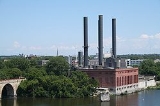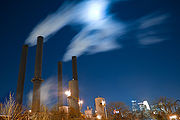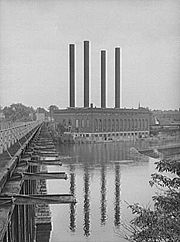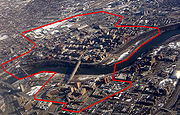
Southeast Steam Plant
Encyclopedia
The Southeast Steam Plant, also known as the Twin City Rapid Transit Company Steam Power Plant, is a combined
heat
and power plant
on the Mississippi River
in the city of Minneapolis, Minnesota
in the United States
owned by the University of Minnesota
.

 The plant was constructed in 1903 to provide electricity
The plant was constructed in 1903 to provide electricity
for the Twin City Rapid Transit
street railway system. It supported the area's major form of public transportation for 50 years.
Minneapolis converted to bus
es in 1949–1954, and in the early 1950s, Northern States Power Company (now Xcel Energy
) acquired the building. The University of Minnesota
purchased the plant in 1976 for $1.
 The facility heats 94 buildings—nearly all of the university's Minneapolis campus, cools 19 of those buildings, and provides steam
The facility heats 94 buildings—nearly all of the university's Minneapolis campus, cools 19 of those buildings, and provides steam
to the University of Minnesota Medical Center
, Minnesota State Board of Health and Cedar Riverside People's Center. Captured as the steam leaves the plant, pressure powers the plant and provides 20% of the university's electricity. The plant's steam is transported through an 18 mile (29 km) network of tunnels to the campus buildings and would be enough to heat 55,000 homes. Each student pays about $200 for energy and those in residence halls pay $375 a year for heat and air conditioning, water heating and dining services.
The plant is university building #059. The university's Energy Management department, part of Facilities Management, oversees the plant. Foster Wheeler Twin Cities
has contracted with the U of M to operate it since 1992.
Just upstream is the Hennepin Island Hydroelectric Plant
operated by Xcel Energy
. The university's Saint Paul, Minnesota
campus three miles (5 km) away has its own plant. In addition the university has generators
, pumps and boilers powered by diesel and natural gas, most used only in emergencies, with 11 used as peak shaving
units.
reduced the ambient temperature to 80°F (27°C), and the loss of energy from 10% to 4%, and over time resulted in a 25% campus-wide decrease in energy consumption.
The university closed the Southeast plant to gut and rebuild the interior, and in 2000, reopened it and closed down its old coal-burning power plant.
Completed in 2005, exterior rehabilitation won a local historic preservation
award, presented to the university and Miller Dunwiddie Architects, McGough Construction, Hess Roise Historical Consultants, Meyer Borgman Johnson, Michaud Cooley Erickson, INSPEC, Akiba Architects, and Kimley Horn.
, coal
and wood
waste. The plant has tested and been approved for oat
hull biofuel
, a renewable resource
that would reduce each student's fees by about $21.
Five boiler
s are operational. A new fluidized bed boiler (CFB) is six stories high and capable of burning coal, wood, oat hulls or natural gas. There are two natural gas boilers, one pulverized coal boiler that can also fire fuel oil, and a spreader stoker coal boiler, also capable of burning fuel oil and possibly oat hulls. During May and October, the periods of lowest demand, the CFB boiler is not in use.
The CFB controls emission
s of the acid gases sulfur dioxide
, hydrogen chloride
and hydrogen fluoride
and particulate matter
(PM) with limestone injection and a fabric filter. The pulverized coal and spreader stoker boilers are equipped with dry gas scrubber
s (spray dryers). Two boilers have no control equipment but have flue
gas recirculation to limit nitrogen oxide emission. The plant emits almost zero sulfur
and mercury
.
The unloading terminal for rail cars and its conveyors are enclosed and equipped with baghouse filters. The outdoor coal bunker is shielded from the wind by concrete retaining walls. Storage silo
s for ash
have fabric filters.
and Larry Pogemiller, Arne Carlson
who was governor of Minnesota
, and Sharon Sayles Belton
who was mayor of Minneapolis supported the move. Concerned about potential emissions and noise from deliveries, some neighborhood associations and a condominium developer at the nearby Pillsbury "A" Mill criticized the plant's 2005 application to amend its permit to allow tests of alternative fuels.
fuels, specifically oat
hulls in 2006 but the three years necessary for testing and the approval process lost the source of the hulls. General Mills
, makers of the oat cereal
Cheerios
, had signed a contract by then with U.S. Steel
for use in their facility on the Iron Range
in northern Minnesota.
Cogeneration
Cogeneration is the use of a heat engine or a power station to simultaneously generate both electricity and useful heat....
heat
District heating
District heating is a system for distributing heat generated in a centralized location for residential and commercial heating requirements such as space heating and water heating...
and power plant
Power station
A power station is an industrial facility for the generation of electric energy....
on the Mississippi River
Mississippi River
The Mississippi River is the largest river system in North America. Flowing entirely in the United States, this river rises in western Minnesota and meanders slowly southwards for to the Mississippi River Delta at the Gulf of Mexico. With its many tributaries, the Mississippi's watershed drains...
in the city of Minneapolis, Minnesota
Minneapolis, Minnesota
Minneapolis , nicknamed "City of Lakes" and the "Mill City," is the county seat of Hennepin County, the largest city in the U.S. state of Minnesota, and the 48th largest in the United States...
in the United States
United States
The United States of America is a federal constitutional republic comprising fifty states and a federal district...
owned by the University of Minnesota
University of Minnesota
The University of Minnesota, Twin Cities is a public research university located in Minneapolis and St. Paul, Minnesota, United States. It is the oldest and largest part of the University of Minnesota system and has the fourth-largest main campus student body in the United States, with 52,557...
.

History

Electricity
Electricity is a general term encompassing a variety of phenomena resulting from the presence and flow of electric charge. These include many easily recognizable phenomena, such as lightning, static electricity, and the flow of electrical current in an electrical wire...
for the Twin City Rapid Transit
Twin City Rapid Transit
The Twin City Rapid Transit Company , also known as Twin City Lines , was a transportation company that operated streetcars, and buses in the Minneapolis-St. Paul metropolitan area in the U.S. state of Minnesota...
street railway system. It supported the area's major form of public transportation for 50 years.
Minneapolis converted to bus
Bus
A bus is a road vehicle designed to carry passengers. Buses can have a capacity as high as 300 passengers. The most common type of bus is the single-decker bus, with larger loads carried by double-decker buses and articulated buses, and smaller loads carried by midibuses and minibuses; coaches are...
es in 1949–1954, and in the early 1950s, Northern States Power Company (now Xcel Energy
Xcel Energy
Xcel Energy, Inc. is a public utility company based in Minneapolis, Minnesota, serving customers in Colorado, Michigan, Minnesota, New Mexico, North Dakota, South Dakota, Texas, and Wisconsin. Primary services are electricity and natural gas...
) acquired the building. The University of Minnesota
University of Minnesota
The University of Minnesota, Twin Cities is a public research university located in Minneapolis and St. Paul, Minnesota, United States. It is the oldest and largest part of the University of Minnesota system and has the fourth-largest main campus student body in the United States, with 52,557...
purchased the plant in 1976 for $1.
Operation

Steam
Steam is the technical term for water vapor, the gaseous phase of water, which is formed when water boils. In common language it is often used to refer to the visible mist of water droplets formed as this water vapor condenses in the presence of cooler air...
to the University of Minnesota Medical Center
University of Minnesota Medical Center
The University of Minnesota Medical Center, Fairview is the main university hospital for the University of Minnesota Medical School. There are two campuses: one located on the East Bank of the Mississippi River, known as the University Campus, and the other located on the West Bank, known as the...
, Minnesota State Board of Health and Cedar Riverside People's Center. Captured as the steam leaves the plant, pressure powers the plant and provides 20% of the university's electricity. The plant's steam is transported through an 18 mile (29 km) network of tunnels to the campus buildings and would be enough to heat 55,000 homes. Each student pays about $200 for energy and those in residence halls pay $375 a year for heat and air conditioning, water heating and dining services.
The plant is university building #059. The university's Energy Management department, part of Facilities Management, oversees the plant. Foster Wheeler Twin Cities
Foster Wheeler Corporation
Foster Wheeler is a global conglomerate incorporated in Switzerland and with its principal executive offices in New Jersey. It is focused on Engineering, Procurement, and Construction and on power...
has contracted with the U of M to operate it since 1992.
Just upstream is the Hennepin Island Hydroelectric Plant
Hennepin Island Hydroelectric Plant
The Hennepin Island Hydroelectric Plant also known as the St. Anthony Hydro Plant, sits on the site of early sawmills at St. Anthony Falls in Minneapolis, Minnesota. The current structure was built for electric power in 1882. It is currently operated by Xcel Energy...
operated by Xcel Energy
Xcel Energy
Xcel Energy, Inc. is a public utility company based in Minneapolis, Minnesota, serving customers in Colorado, Michigan, Minnesota, New Mexico, North Dakota, South Dakota, Texas, and Wisconsin. Primary services are electricity and natural gas...
. The university's Saint Paul, Minnesota
Saint Paul, Minnesota
Saint Paul is the capital and second-most populous city of the U.S. state of Minnesota. The city lies mostly on the east bank of the Mississippi River in the area surrounding its point of confluence with the Minnesota River, and adjoins Minneapolis, the state's largest city...
campus three miles (5 km) away has its own plant. In addition the university has generators
Electrical generator
In electricity generation, an electric generator is a device that converts mechanical energy to electrical energy. A generator forces electric charge to flow through an external electrical circuit. It is analogous to a water pump, which causes water to flow...
, pumps and boilers powered by diesel and natural gas, most used only in emergencies, with 11 used as peak shaving
Peaking power plant
Peaking power plants, also known as peaker plants, and occasionally just "peakers," are power plants that generally run only when there is a high demand, known as peak demand, for electricity.-Peak hours:...
units.
Rehabilitation
Before pipes were reinsulated, employees needed breaks once an hour to work in the tunnels which reached 115°F (46°C). InsulationThermal insulation
Thermal insulation is the reduction of the effects of the various processes of heat transfer between objects in thermal contact or in range of radiative influence. Heat transfer is the transfer of thermal energy between objects of differing temperature...
reduced the ambient temperature to 80°F (27°C), and the loss of energy from 10% to 4%, and over time resulted in a 25% campus-wide decrease in energy consumption.
The university closed the Southeast plant to gut and rebuild the interior, and in 2000, reopened it and closed down its old coal-burning power plant.
Completed in 2005, exterior rehabilitation won a local historic preservation
Historic preservation
Historic preservation is an endeavor that seeks to preserve, conserve and protect buildings, objects, landscapes or other artifacts of historical significance...
award, presented to the university and Miller Dunwiddie Architects, McGough Construction, Hess Roise Historical Consultants, Meyer Borgman Johnson, Michaud Cooley Erickson, INSPEC, Akiba Architects, and Kimley Horn.
Boilers, fuel and emissions
Among the "cleanest burning power plants in the country," the high temperature fires almost completely consume its fuels—natural gasNatural gas
Natural gas is a naturally occurring gas mixture consisting primarily of methane, typically with 0–20% higher hydrocarbons . It is found associated with other hydrocarbon fuel, in coal beds, as methane clathrates, and is an important fuel source and a major feedstock for fertilizers.Most natural...
, coal
Coal
Coal is a combustible black or brownish-black sedimentary rock usually occurring in rock strata in layers or veins called coal beds or coal seams. The harder forms, such as anthracite coal, can be regarded as metamorphic rock because of later exposure to elevated temperature and pressure...
and wood
Wood
Wood is a hard, fibrous tissue found in many trees. It has been used for hundreds of thousands of years for both fuel and as a construction material. It is an organic material, a natural composite of cellulose fibers embedded in a matrix of lignin which resists compression...
waste. The plant has tested and been approved for oat
Oat
The common oat is a species of cereal grain grown for its seed, which is known by the same name . While oats are suitable for human consumption as oatmeal and rolled oats, one of the most common uses is as livestock feed...
hull biofuel
Biofuel
Biofuel is a type of fuel whose energy is derived from biological carbon fixation. Biofuels include fuels derived from biomass conversion, as well as solid biomass, liquid fuels and various biogases...
, a renewable resource
Renewable resource
A renewable resource is a natural resource with the ability of being replaced through biological or other natural processes and replenished with the passage of time...
that would reduce each student's fees by about $21.
Five boiler
Boiler
A boiler is a closed vessel in which water or other fluid is heated. The heated or vaporized fluid exits the boiler for use in various processes or heating applications.-Materials:...
s are operational. A new fluidized bed boiler (CFB) is six stories high and capable of burning coal, wood, oat hulls or natural gas. There are two natural gas boilers, one pulverized coal boiler that can also fire fuel oil, and a spreader stoker coal boiler, also capable of burning fuel oil and possibly oat hulls. During May and October, the periods of lowest demand, the CFB boiler is not in use.
The CFB controls emission
Exhaust gas
Exhaust gas or flue gas is emitted as a result of the combustion of fuels such as natural gas, gasoline/petrol, diesel fuel, fuel oil or coal. According to the type of engine, it is discharged into the atmosphere through an exhaust pipe, flue gas stack or propelling nozzle.It often disperses...
s of the acid gases sulfur dioxide
Sulfur dioxide
Sulfur dioxide is the chemical compound with the formula . It is released by volcanoes and in various industrial processes. Since coal and petroleum often contain sulfur compounds, their combustion generates sulfur dioxide unless the sulfur compounds are removed before burning the fuel...
, hydrogen chloride
Hydrogen chloride
The compound hydrogen chloride has the formula HCl. At room temperature, it is a colorless gas, which forms white fumes of hydrochloric acid upon contact with atmospheric humidity. Hydrogen chloride gas and hydrochloric acid are important in technology and industry...
and hydrogen fluoride
Hydrogen fluoride
Hydrogen fluoride is a chemical compound with the formula HF. This colorless gas is the principal industrial source of fluorine, often in the aqueous form as hydrofluoric acid, and thus is the precursor to many important compounds including pharmaceuticals and polymers . HF is widely used in the...
and particulate matter
Particulates
Particulates – also known as particulate matter , suspended particulate matter , fine particles, and soot – are tiny subdivisions of solid matter suspended in a gas or liquid. In contrast, aerosol refers to particles and/or liquid droplets and the gas together. Sources of particulate matter can be...
(PM) with limestone injection and a fabric filter. The pulverized coal and spreader stoker boilers are equipped with dry gas scrubber
Scrubber
Scrubber systems are a diverse group of air pollution control devices that can be used to remove some particulates and/or gases from industrial exhaust streams. Traditionally, the term "scrubber" has referred to pollution control devices that use liquid to wash unwanted pollutants from a gas stream...
s (spray dryers). Two boilers have no control equipment but have flue
Flue
A flue is a duct, pipe, or chimney for conveying exhaust gases from a fireplace, furnace, water heater, boiler, or generator to the outdoors. In the United States, they are also known as vents and for boilers as breeching for water heaters and modern furnaces...
gas recirculation to limit nitrogen oxide emission. The plant emits almost zero sulfur
Sulfur
Sulfur or sulphur is the chemical element with atomic number 16. In the periodic table it is represented by the symbol S. It is an abundant, multivalent non-metal. Under normal conditions, sulfur atoms form cyclic octatomic molecules with chemical formula S8. Elemental sulfur is a bright yellow...
and mercury
Mercury (element)
Mercury is a chemical element with the symbol Hg and atomic number 80. It is also known as quicksilver or hydrargyrum...
.
The unloading terminal for rail cars and its conveyors are enclosed and equipped with baghouse filters. The outdoor coal bunker is shielded from the wind by concrete retaining walls. Storage silo
Storage silo
A silo is a structure for storing bulk materials. Silos are used in agriculture to store grain or fermented feed known as silage. Silos are more commonly used for bulk storage of grain, coal, cement, carbon black, woodchips, food products and sawdust. Three types of silos are in widespread use...
s for ash
Fly ash
Fly ash is one of the residues generated in combustion, and comprises the fine particles that rise with the flue gases. Ash which does not rise is termed bottom ash. In an industrial context, fly ash usually refers to ash produced during combustion of coal...
have fabric filters.
Criticism
Environmental groups including the Save Our Riverfront Coalition and Friends of the Mississippi Inc. attempted and failed to move the plant off the river in 1996. Elected officials Phyllis KahnPhyllis Kahn
Phyllis Kahn is a retired professor of Biophysics and a DFL member of the Minnesota House of Representatives, serving District 59B, which includes portions of the city of Minneapolis in Hennepin County, which is in the Twin Cities metropolitan area. Educated at Cornell , Yale Phyllis Kahn (born...
and Larry Pogemiller, Arne Carlson
Arne Carlson
Arne Helge Carlson, Sr. is an American politician and the 37th Governor of the state of Minnesota.-Early years, education and family:...
who was governor of Minnesota
Governor of Minnesota
The Governor of Minnesota is the chief executive of the U.S. state of Minnesota, leading the state's executive branch. Forty different people have been governors of the state, though historically there were also three governors of Minnesota Territory. Alexander Ramsey, the first territorial...
, and Sharon Sayles Belton
Sharon Sayles Belton
Sharon Sayles Belton is an American community leader, politician and activist. She is currently the VP of Community Relations and Government Affairs for Thomson Reuters Legal business.-Early years:...
who was mayor of Minneapolis supported the move. Concerned about potential emissions and noise from deliveries, some neighborhood associations and a condominium developer at the nearby Pillsbury "A" Mill criticized the plant's 2005 application to amend its permit to allow tests of alternative fuels.
Biofuel
The Minnesota Pollution Control Agency approved use of biomassBiomass
Biomass, as a renewable energy source, is biological material from living, or recently living organisms. As an energy source, biomass can either be used directly, or converted into other energy products such as biofuel....
fuels, specifically oat
Oat
The common oat is a species of cereal grain grown for its seed, which is known by the same name . While oats are suitable for human consumption as oatmeal and rolled oats, one of the most common uses is as livestock feed...
hulls in 2006 but the three years necessary for testing and the approval process lost the source of the hulls. General Mills
General Mills
General Mills, Inc. is an American Fortune 500 corporation, primarily concerned with food products, which is headquartered in Golden Valley, Minnesota, a suburb of Minneapolis. The company markets many well-known brands, such as Betty Crocker, Yoplait, Colombo, Totinos, Jeno's, Pillsbury, Green...
, makers of the oat cereal
Cereal
Cereals are grasses cultivated for the edible components of their grain , composed of the endosperm, germ, and bran...
Cheerios
Cheerios
Cheerios is a brand of breakfast cereal by General Mills introduced on May 1, 1941 as the first oat-based, ready-to-eat cold cereal. Originally named CheeriOats, the name was changed to Cheerios in 1945 because of a trade name dispute with Quaker Oats. The name fit the "O" shape of the cereal pieces...
, had signed a contract by then with U.S. Steel
U.S. Steel
The United States Steel Corporation , more commonly known as U.S. Steel, is an integrated steel producer with major production operations in the United States, Canada, and Central Europe. The company is the world's tenth largest steel producer ranked by sales...
for use in their facility on the Iron Range
Iron Range
The Iron Range is a region that makes up the northeastern section of Minnesota in the United States. "The Range", as it is known by locals, is a region with multiple distinct bands of iron ore...
in northern Minnesota.

